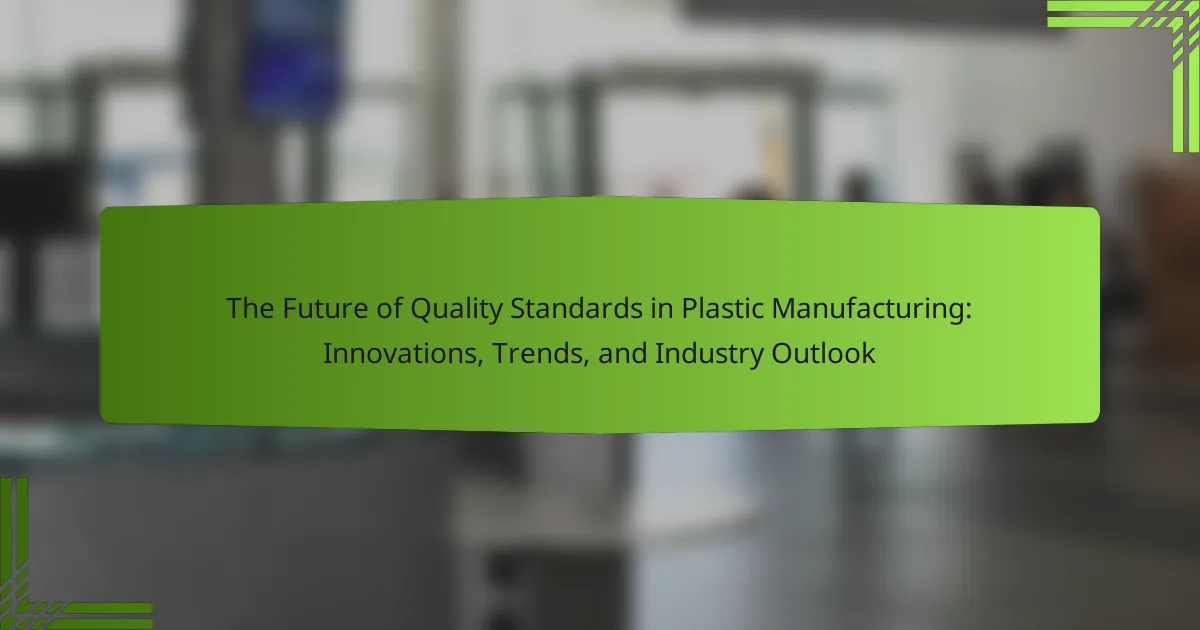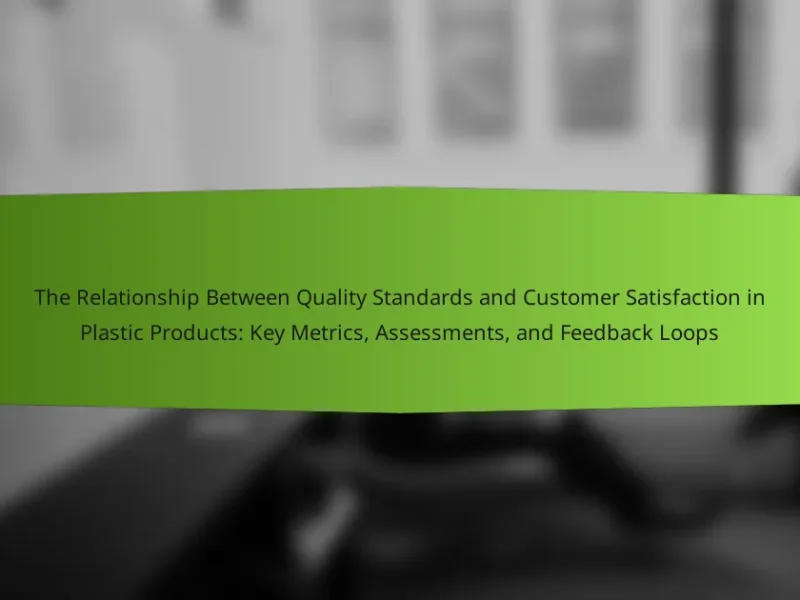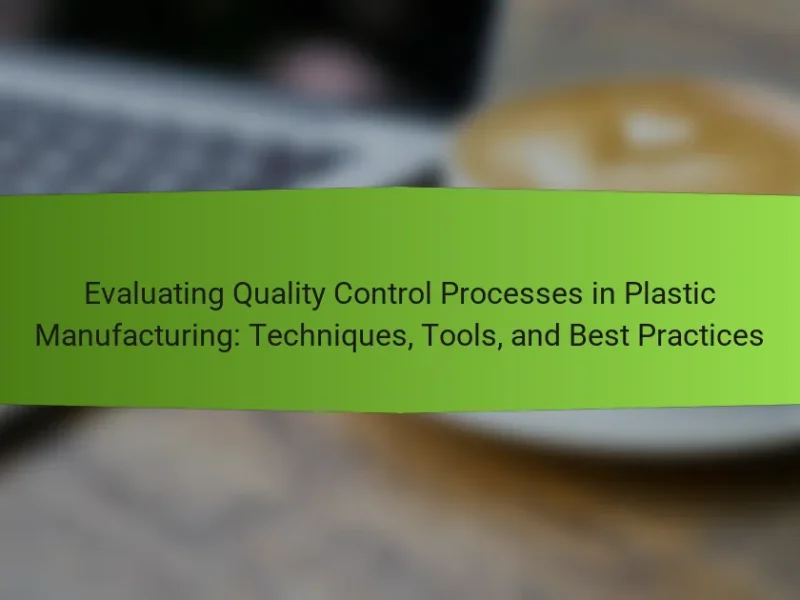The article focuses on the evolving quality standards in plastic manufacturing, highlighting key frameworks such as ISO 9001, ASTM standards, and FDA regulations. It examines the role of advanced quality control technologies, including automation, artificial intelligence, and IoT devices, in enhancing product safety and quality. The discussion also addresses the increasing emphasis on sustainability, with innovations in biodegradable materials and recycling processes shaping industry practices. Additionally, the article outlines the growing importance of compliance with stricter regulations and the shift towards circular economy practices, indicating a significant transformation in quality benchmarks within the plastic manufacturing sector.
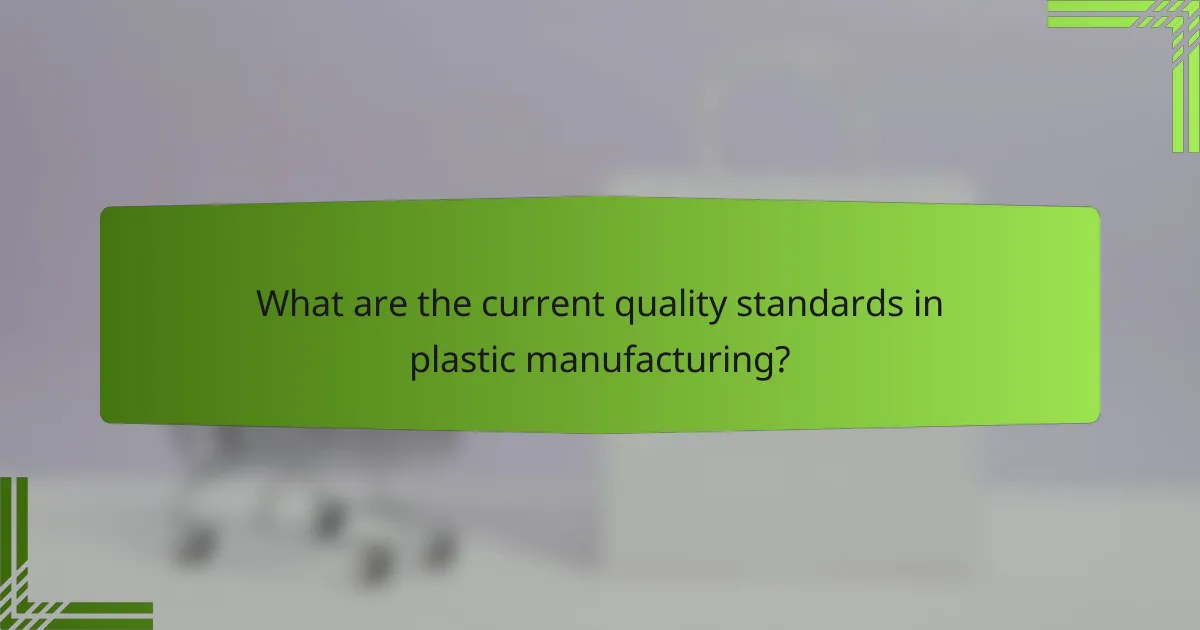
What are the current quality standards in plastic manufacturing?
Current quality standards in plastic manufacturing include ISO 9001, ASTM standards, and FDA regulations. ISO 9001 focuses on quality management systems and continuous improvement. ASTM standards provide specifications for materials and testing methods. FDA regulations ensure that plastics used in food packaging are safe for consumer use. Compliance with these standards is critical for manufacturers to maintain product safety and quality. Organizations often undergo audits to verify adherence to these standards. This process helps ensure that the products meet industry requirements and consumer expectations.
How do these standards impact production processes?
Quality standards significantly impact production processes by establishing benchmarks for efficiency and safety. These standards guide manufacturers in optimizing their workflows. They ensure consistency in product quality, which reduces waste and defects. Compliance with standards often leads to improved operational efficiency. For instance, ISO 9001 certification can enhance process control and customer satisfaction. Additionally, adherence to environmental standards can minimize the ecological footprint of production. Ultimately, these standards drive innovation and competitiveness in the plastic manufacturing industry.
What specific quality metrics are used in plastic manufacturing?
Specific quality metrics used in plastic manufacturing include tensile strength, impact resistance, and dimensional stability. Tensile strength measures how much force a plastic can withstand before breaking. Impact resistance evaluates a plastic’s ability to absorb energy during sudden impacts. Dimensional stability assesses how much a plastic retains its shape under varying temperature and humidity conditions. Other metrics include melt flow index, which indicates the viscosity of the plastic when melted, and moisture content, which affects the material’s performance. These metrics are essential for ensuring that the final products meet industry standards and customer expectations.
How are these metrics measured and evaluated?
Metrics in plastic manufacturing are measured and evaluated through various quantitative and qualitative methods. Commonly, production output, defect rates, and compliance with quality standards are tracked. Statistical process control (SPC) tools are used to monitor variations in manufacturing processes. Additionally, key performance indicators (KPIs) are established to assess efficiency and effectiveness. Data collection often involves automated systems and manual inspections. Evaluations are conducted periodically to ensure adherence to industry benchmarks. Industry standards such as ISO 9001 provide frameworks for consistent quality assessment. Regular audits and reviews contribute to the ongoing evaluation of these metrics.
Why are quality standards essential for plastic manufacturers?
Quality standards are essential for plastic manufacturers to ensure product safety and reliability. They help maintain consistent quality in production processes. Adhering to these standards minimizes defects and reduces waste. This leads to cost savings and improved efficiency. Quality standards also enhance customer satisfaction by guaranteeing that products meet specifications. Regulatory compliance is another critical factor, as many industries require adherence to specific standards. Furthermore, quality standards foster innovation by encouraging manufacturers to adopt new technologies and practices. In 2020, the global plastic market was valued at approximately $570 billion, highlighting the importance of quality in a competitive industry.
What risks are associated with non-compliance to quality standards?
Non-compliance to quality standards poses significant risks to organizations. These risks include product recalls, which can lead to financial losses and damage to brand reputation. Legal penalties may also arise from failing to meet regulatory requirements. Additionally, non-compliance can result in decreased customer trust and loyalty. This can ultimately affect market share and profitability. Research indicates that companies with poor compliance records face higher operational costs. Furthermore, non-compliance can lead to increased safety hazards, risking employee welfare and safety. These factors highlight the critical importance of adhering to established quality standards in plastic manufacturing.
How do quality standards enhance consumer trust?
Quality standards enhance consumer trust by ensuring product reliability and safety. When manufacturers adhere to established quality standards, they demonstrate a commitment to maintaining high production values. This consistency in quality reassures consumers about the products they purchase. For instance, products certified under ISO standards are often perceived as more trustworthy. Research shows that 70% of consumers are more likely to buy from brands that meet recognized quality standards. Additionally, transparency in the quality assurance process fosters confidence among consumers. Trust is further solidified when companies actively communicate their compliance with these standards. Overall, quality standards serve as a benchmark for consumer expectations and satisfaction.
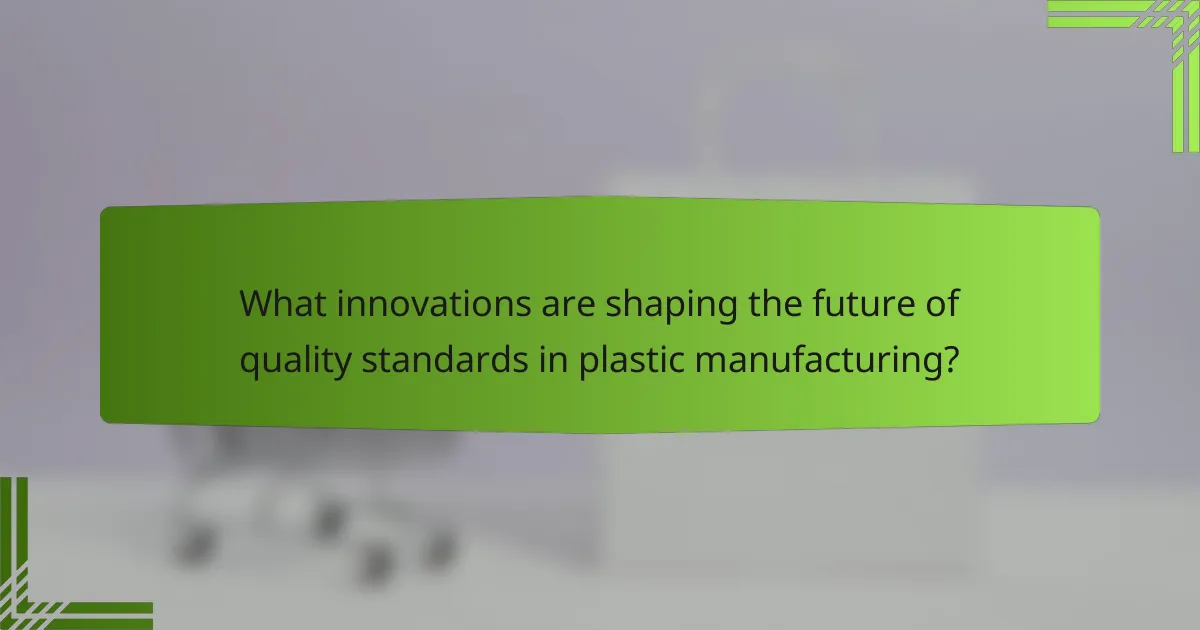
What innovations are shaping the future of quality standards in plastic manufacturing?
Advanced quality control technologies are shaping the future of quality standards in plastic manufacturing. Automation and artificial intelligence are increasingly used to monitor production processes. These technologies enhance precision and reduce human error. Real-time data analytics allows manufacturers to identify defects promptly. Moreover, the integration of IoT devices enables continuous monitoring of material properties. This leads to improved consistency in product quality. Sustainable practices are also influencing quality standards. Biodegradable materials and recycling processes are being prioritized. Innovations in material science are creating stronger and lighter plastics. These advancements ensure compliance with evolving regulatory requirements.
How is technology influencing quality assurance practices?
Technology is significantly influencing quality assurance practices by automating processes and enhancing data analysis. Automation reduces human error and increases efficiency in testing and inspection. Advanced software tools enable real-time monitoring of production quality. Machine learning algorithms analyze large datasets to identify patterns and predict potential defects. Additionally, technologies like IoT devices provide continuous data collection from manufacturing equipment. This data helps in maintaining consistent quality standards. According to a report by McKinsey, companies using advanced analytics in quality assurance see a 30% reduction in defects. These innovations lead to improved product reliability and customer satisfaction.
What role do automation and AI play in quality control?
Automation and AI enhance quality control by increasing efficiency and accuracy. They enable real-time monitoring of production processes. This reduces human error and allows for immediate adjustments. AI algorithms analyze data to predict potential defects. Automated systems perform inspections faster than manual methods. According to a study by McKinsey, AI can improve quality assurance processes by up to 30%. Automation also streamlines repetitive tasks, freeing human resources for more complex issues. These technologies collectively lead to higher product consistency and reduced waste.
How are advancements in materials science affecting quality standards?
Advancements in materials science significantly enhance quality standards in plastic manufacturing. New materials improve durability, strength, and performance. These advancements lead to stricter testing protocols and specifications. Enhanced materials allow for better compliance with environmental regulations. For instance, bioplastics are replacing traditional plastics, necessitating updated quality benchmarks. Innovations such as nanotechnology contribute to superior material properties. As a result, manufacturers must adapt their quality control processes. This evolution ensures products meet higher safety and performance criteria.
What are the emerging trends in quality standards for plastic manufacturing?
Emerging trends in quality standards for plastic manufacturing include increased focus on sustainability and recyclability. Manufacturers are adopting standards that prioritize eco-friendly materials. There is a growing demand for transparency in sourcing and production processes. Automation and digitalization are enhancing quality control measures. Advanced technologies like AI and IoT are being integrated for real-time monitoring. Compliance with international regulations is becoming more stringent. The use of lifecycle assessments is rising to evaluate environmental impact. These trends reflect a shift towards more responsible manufacturing practices.
How is sustainability driving changes in quality standards?
Sustainability is driving changes in quality standards by emphasizing eco-friendly materials and processes. Manufacturers are now required to meet stricter environmental regulations. This shift prioritizes the lifecycle impact of products. Companies are adopting standards that reduce waste and energy consumption. For instance, the ISO 14001 standard focuses on effective environmental management systems. Additionally, consumers increasingly demand sustainable products, influencing brand reputations. Research shows that sustainable practices can lead to cost savings over time. The integration of sustainability into quality standards fosters innovation in material development and manufacturing techniques.
What impact does globalization have on quality standards?
Globalization significantly influences quality standards across industries. It facilitates the harmonization of standards internationally. This leads to improved product consistency and safety. Companies must comply with global standards to access international markets. Enhanced competition drives innovation and quality improvement. For instance, the International Organization for Standardization (ISO) sets global benchmarks. Adhering to these standards can enhance brand reputation and consumer trust. Globalization also encourages knowledge sharing and best practices among manufacturers.
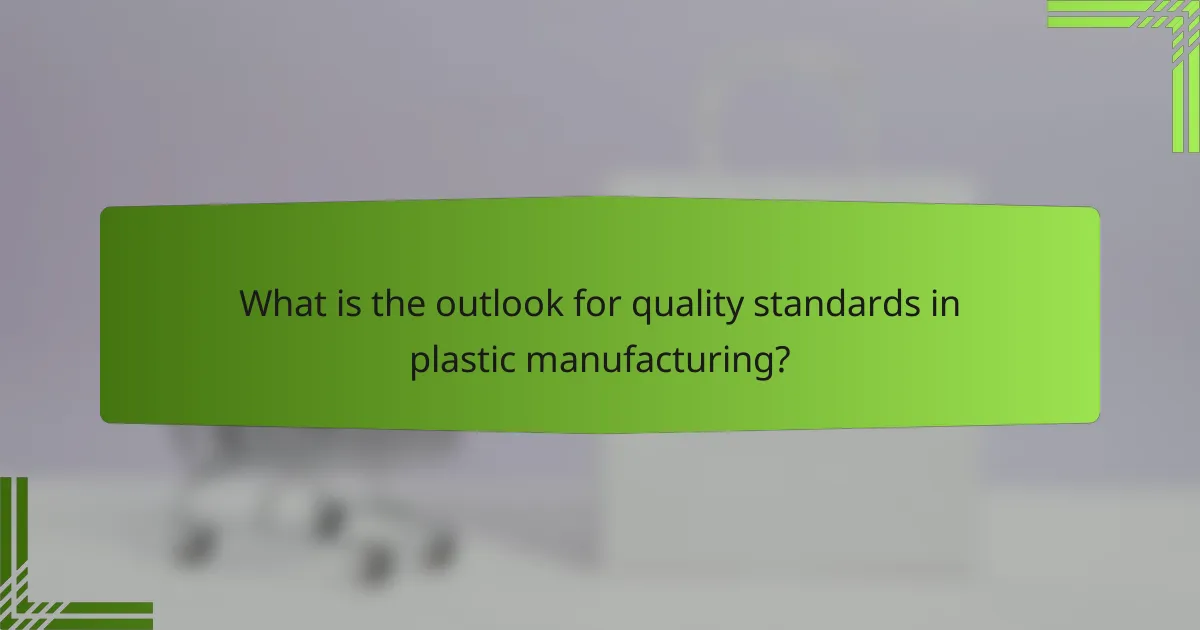
What is the outlook for quality standards in plastic manufacturing?
The outlook for quality standards in plastic manufacturing is increasingly focused on sustainability and compliance. Manufacturers are adopting stricter regulations to ensure product safety and environmental protection. Innovations in materials are leading to improved quality benchmarks. Advanced technologies, such as automation and AI, enhance quality control processes. Industry standards are evolving to include recyclability and biodegradability as key metrics. Companies are investing in certifications to meet global standards. The shift towards circular economy practices is driving these changes. Overall, the emphasis on quality standards is expected to grow significantly in the coming years.
How will regulatory changes affect future quality standards?
Regulatory changes will significantly impact future quality standards in plastic manufacturing. New regulations often introduce stricter requirements for materials, production processes, and environmental compliance. These changes aim to enhance product safety and sustainability. For instance, the European Union’s REACH regulation mandates the registration and evaluation of chemical substances used in plastics. Compliance with such regulations can lead to improved manufacturing practices and higher quality products. Additionally, regulatory shifts can drive innovation by encouraging the development of alternative materials and eco-friendly processes. Companies that adapt to these changes may gain a competitive edge in the market.
What upcoming legislation should manufacturers be aware of?
Manufacturers should be aware of the upcoming legislation concerning plastic waste reduction. This legislation aims to enforce stricter regulations on plastic production and recycling. The European Union is leading these efforts with the Circular Economy Action Plan. This plan includes measures to ensure that all plastic packaging is reusable or recyclable by 2030. Additionally, the U.S. is considering similar policies to limit single-use plastics. These legislative changes are driven by increasing environmental concerns and sustainability goals. Compliance will require manufacturers to adapt their production processes. Failure to comply could result in significant fines and penalties.
How can manufacturers prepare for these regulatory shifts?
Manufacturers can prepare for regulatory shifts by conducting thorough assessments of current compliance measures. They should stay informed about upcoming regulations through industry associations and regulatory bodies. Training staff on new compliance requirements is essential for ensuring adherence. Investing in technology that enhances traceability and reporting can streamline compliance processes. Collaborating with suppliers to ensure their compliance is also important. Regularly reviewing and updating internal policies will help manufacturers remain agile. Engaging in proactive discussions with regulators can provide insights into future changes. These strategies collectively enhance readiness for regulatory transformations in the industry.
What best practices can manufacturers adopt to meet future quality standards?
Manufacturers can adopt several best practices to meet future quality standards. Implementing robust quality management systems is essential. These systems should include continuous monitoring and improvement processes. Regular training for employees on quality standards enhances compliance. Utilizing advanced technologies, such as automation and AI, can improve precision. Conducting regular audits ensures adherence to quality protocols. Collaborating with suppliers to maintain quality throughout the supply chain is crucial. Engaging in customer feedback loops helps identify areas for improvement. Lastly, staying informed about evolving regulations and standards is vital for ongoing compliance.
How can continuous improvement methodologies enhance quality assurance?
Continuous improvement methodologies enhance quality assurance by systematically identifying and eliminating inefficiencies. These methodologies, such as Lean and Six Sigma, focus on process optimization. They promote a culture of ongoing assessment and refinement. This leads to higher product consistency and reduced defects. For example, Lean principles can reduce waste, improving overall efficiency. Six Sigma utilizes data-driven techniques to minimize variability in processes. The application of these methodologies has been shown to increase customer satisfaction significantly. According to a study by the American Society for Quality, organizations implementing continuous improvement see a 20% increase in quality metrics.
What training programs are essential for maintaining high-quality standards?
Essential training programs for maintaining high-quality standards in plastic manufacturing include ISO 9001 certification training, Six Sigma training, and Lean Manufacturing training. ISO 9001 certification training focuses on quality management systems and helps organizations meet customer and regulatory requirements. Six Sigma training emphasizes process improvement and reducing defects, which is critical for maintaining product quality. Lean Manufacturing training teaches techniques for minimizing waste while maximizing productivity, directly impacting quality outcomes. These programs equip employees with the necessary skills to uphold high standards in production processes. Implementing these training programs has been shown to enhance overall quality, reduce costs, and improve customer satisfaction in the plastic manufacturing industry.
The main entity of the article is quality standards in plastic manufacturing. The article provides a comprehensive overview of the current quality standards, including ISO 9001, ASTM standards, and FDA regulations, and discusses their impact on production processes and specific quality metrics. It highlights the importance of compliance for manufacturers, the risks associated with non-compliance, and how advancements in technology and materials science are shaping future standards. Additionally, the article explores emerging trends such as sustainability, globalization, and regulatory changes, offering insights into best practices for manufacturers to maintain high-quality standards.
